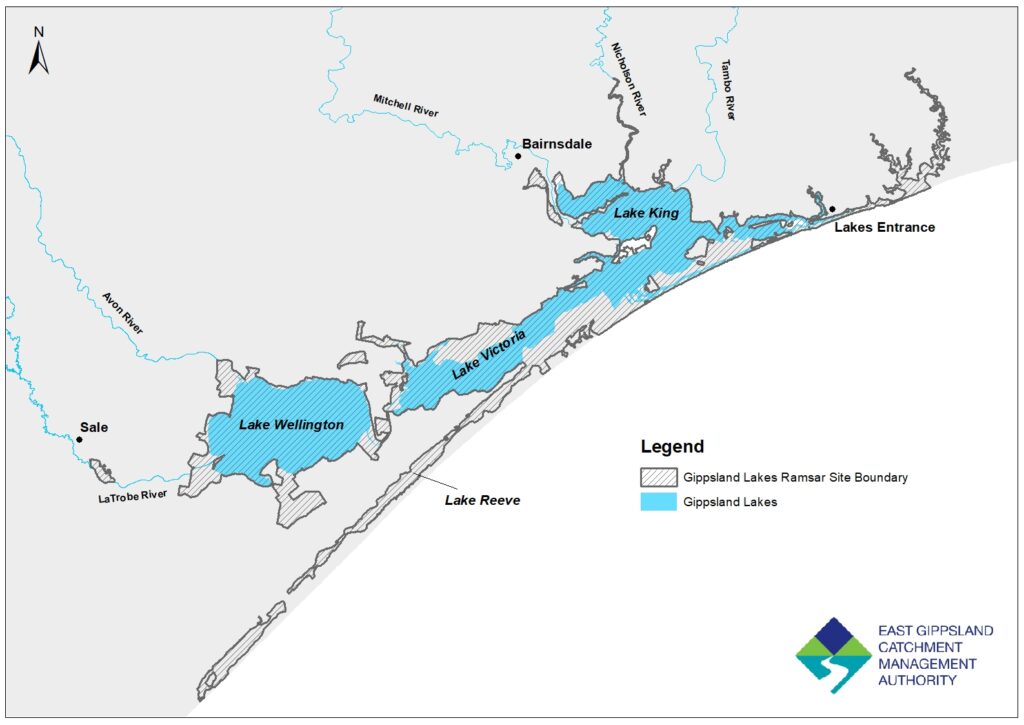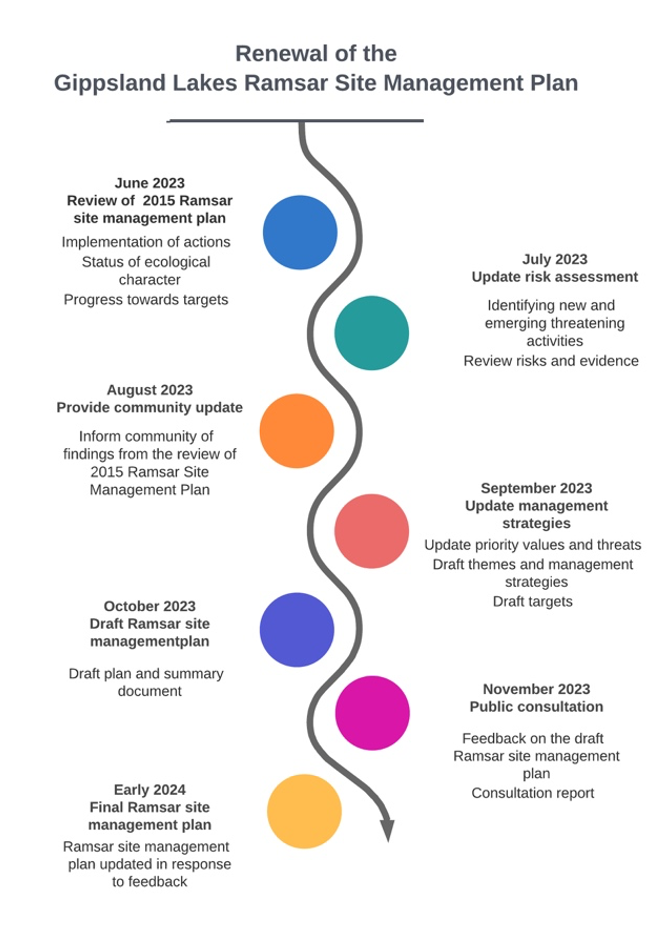The Gippsland Lakes Ramsar Site is one of twelve wetlands listed under the Ramsar Convention in Victoria and one of 64 wetlands areas in Australia, listed as a Wetland of International Importance under the Convention on Wetlands of International Importance (Ramsar Convention).
The Lakes we listed in 1982 and are recognised for outstanding significant coastal wetland values and features, including vital habitat for migratory bird species as well as supporting other crucial ecosystem services including nationally and internationally threatened wetland species, waterbird breeding and fish spawning sites.
The Gippsland Lakes are also an important tourism destination for the region, supporting commercial and recreational fisheries, boating, camping and general visitation activities.

Managing such a large and complex natural system requires a strategic approach to direct government and community resources. The Gippsland Lakes Ramsar Site Management Plan (GLRSMP) provides the framework to protect the environmental values of the Gippsland Lakes to maintain the ecological character of the Ramsar site, as required under the Ramsar Convention on Wetlands.
The GLRSMP outlines key management strategies for the site based around five key themes:
- Maintaining and restoring habitats
- Protecting fauna
- Managing nutrients and sediments
- Managing water regimes
- Integrating Aboriginal knowledge and management.
The GLRSMP also identifies management strategies to address critical knowledge gaps which were identified by stakeholders during the development of the plan.
As the Ramsar Site Coordinator, it is the role of the East Gippsland Catchment Management Authority (EGCMA) to coordinate the implementation of the GLRSMP with regional delivery partners. The GLRSMP documents the management and monitoring strategies required to protect, monitor and maintain the ecological character of the Gippsland Lakes Ramsar site.
Renewal of the Gippsland Lakes Ramsar Site Management Plan
The East Gippsland Catchment Management Authority is renewing the Gippsland Lakes Ramsar Site Management Plan. The plan establishes the framework for the maintenance of the site’s unique ecological character through the promotion of conservation and wise sustainable use.
The current plan is seven years old and there has been significant progress in our understanding of the ecological character of the Gippsland Lakes, threats to ecological character, and the strategic direction and management of Ramsar wetlands in Victoria.
The draft Gippsland Lakes Ramsar Site Management Plan (2023) was open for public comment between 29 November 2023 and 19 January 2024 on the EngageVic website. We received over 20 submissions on the plan and thank everyone who provided feedback.
The East Gippsland Catchment Management Authority and Ramsar Coordinating Committee have now reviewed all responses on the draft plan and have prepared a summary of the community feedback and proposed changes to the plan in a Community Consultation Report (PDF – 2MB).
The next steps are finalisation of the Gippsland Lakes Management Plan which will be released here and via the East Gippsland Catchment Management Authority website.


Q. What is Ramsar?
The Convention on Wetlands of International Importance, more commonly referred to as the ‘Ramsar Convention’, was ratified in the Iranian City of Ramsar in 1971. The Convention saw the adoption of a world first international environmental treaty with the broad aims of halting and, where possible, reversing, the worldwide loss of wetlands and to conserve those that remain through wise use and effective management.
Under the terms of the Convention contracting parties nominate wetlands to be designated as Wetlands of International Importance, with nominated sites (Ramsar sites) required to meet at least one of nine listing criteria. The criteria consider factors such as the uniqueness of the wetland, the threatened species and communities it supports and the importance of the site for their survival. The act of designating a wetland as a Ramsar site carries with it certain obligations, including managing the site to maintain its ‘ecological character’ and to have procedures in place to detect if any threatening processes are likely to, or have altered, the ‘ecological character’.
Ecological character is defined as:
“The combination of the ecosystem components, processes and benefits/services [C.P.S] that characterise the wetlands at a given point in time” and “…change in ecological character is the human induced adverse alteration of any ecosystem component, process and or ecosystem benefit/service.”
Ref: Ramsar Convention (2005)
The Ecological Character Description for the Gippsland Lakes, describes the ecological character of a wetland at the time of its listing as a Wetland of International Importance.
Q. Where is the Gippsland Lakes Ramsar site?
The Gippsland Lakes Ramsar Site is located approximately 300 km east of Melbourne in the state of Victoria in south-east Australia. The site extends from Sale Common east to Lake Tyers covering an area of approximately 60,000 hectares.
Q. Why is the Ramsar site important?
The Gippsland Lakes are recognised internationally as a Ramsar site for their very significant environmental values. The site is important for the abundance and diversity of wetland areas, waterbirds and native fish as well as a range of wetland types that support habitat for threatened species, important vegetation communities and migratory bird species.
Q. Who is responsible for managing the site?
East Gippsland Catchment Management Authority is the Ramsar ‘site coordinator’ for the Gippsland Lakes and through this role has a responsibility for the implementation of the Gippsland Lakes Ramsar Site Management Plan and its renewal.
The Gippsland Lakes Ramsar Site has a variety of land tenures and waters that are managed by different organisations including Traditional Owners (represented by the Gunaikurnai Land and Waters Aboriginal Corporation and the Gunaikurnai Traditional Owner Land Management Board), Parks Victoria, DEECA, Gippsland Ports, East Gippsland Shire Council and Wellington Shire Council. Several other agencies, including Catchment Management Authorities, have key responsibilities for catchment, land, water resources and waterways. Management of this large and complex natural system requires a strategic approach to direct government and community resources.
Q. What is a Ramsar Site Management Plan?
The Gippsland Lakes Ramsar Site Management Plan establishes the framework for the maintenance of the site’s ecological character through conservation and wise use. The concept of ‘wise use’ is about maintaining wetland values and functions, while at the same time allowing for sustainable human activities such as water use, recreation, and fishing.
2015 Gippsland Lakes Ramsar Management Plan – Summary Report (PDF 4MB)
2015 Gippsland Lakes Ramsar Site Management Plan – Full Report (PDF 7MB)
Q. What is included in the scope of the plan?
The Gippsland Lakes Ramsar Site Management Plan:
- Identifies the priority values and threats of the site, and through a detailed risk assessment determines priority actions to target the conservation and maintenance of the ecological character of the site
- Identifies responsibility for high level strategic actions across each agency
- Considers and provides guidance for monitoring and reporting on the state of the wetland’s ecological character on an ongoing basis
- Is developed in consultation with people who have a particular interest in the wetland and include processes that provide for the continuing community and technical input.
Q. Why is the plan being updated?
A requirement of listing under the Ramsar Convention is that the management plan is reviewed at intervals of no more than seven years. There has also been significant progress in our understanding of the Gippsland Lakes and actions that can be undertaken to address key threats to the site’s ecological character.
Q. How can we have a say?
The collaborative and collaboration process that was underway has now closed, we thank you for your feedback and we will keep you posted.
Q. When will the new plan be released?
Early 2024, once it has been approved by the Minister for Water.